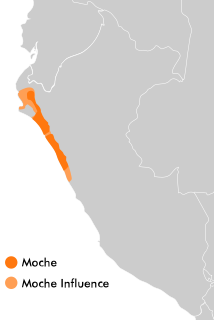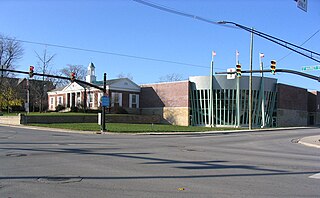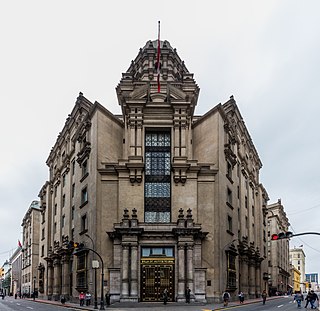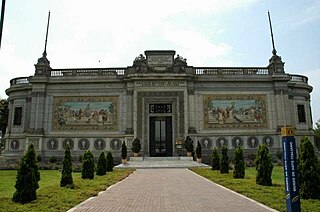This article includes a list of references, related reading or external links, but its sources remain unclear because it lacks inline citations .(January 2013) (Learn how and when to remove this template message) |
 | |
| Location | Lima, Peru |
|---|---|


The Museum of the Nation(Museo de la Nación) is one of two major museums of Peruvian history in Lima, Peru. It is much larger than the other main museum in Lima, the Peruvian National Museum of Archaeology, Anthropology, and History.
The history of Peru spans 4 millennia, extending back through several stages of cultural development in the mountain region and the lakes. Peru was home to the Norte Chico civilization, the oldest civilization in the Americas and one of the six oldest in the world, and to the Inca Empire, the largest and most advanced state in Pre-Columbian America. It was conquered by the Spanish Empire in the 16th century, which established a Viceroyalty with jurisdiction over most of its South American domains. The nation declared independence from Spain in 1821, but consolidated only after the Battle of Ayacucho, three years later.

Lima is the capital and the largest city of Peru. It is located in the valleys of the Chillón, Rímac and Lurín rivers, in the central coastal part of the country, overlooking the Pacific Ocean. Together with the seaport of Callao, it forms a contiguous urban area known as the Lima Metropolitan Area. With a population of more than 9 million, Lima is the most populous metropolitan area of Peru and the third-largest city in the Americas, behind São Paulo and Mexico City.

Peru, officially the Republic of Peru, is a country in western South America. It is bordered in the north by Ecuador and Colombia, in the east by Brazil, in the southeast by Bolivia, in the south by Chile, and in the west by the Pacific Ocean. Peru is a megadiverse country with habitats ranging from the arid plains of the Pacific coastal region in the west to the peaks of the Andes mountains vertically extending from the north to the southeast of the country to the tropical Amazon Basin rainforest in the east with the Amazon river.
Contents
Normally, the Museum of the Nation houses thousands of artifacts spanning the entire span of human occupation in Peru, including an impressive collection of Moche, Nazca, and Wari ceramics. The museum also houses reproductions of many famous ancient Andean artifacts, most notably the Lanzón from Chavín de Huantar ; a recreation of the burial chamber of the Lord of Sipan (El Señor de Sipán); and the famous Revolt of the Objects Mural. However it is currently undergoing remodelling so for the most part only temporary exhibitions are available for the public to view.
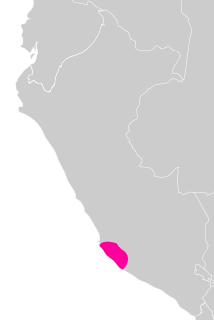
The Nazca culture was the archaeological culture that flourished from c. 100 BC to 800 AD beside the arid, southern coast of Peru in the river valleys of the Rio Grande de Nazca drainage and the Ica Valley. Having been heavily influenced by the preceding Paracas culture, which was known for extremely complex textiles, the Nazca produced an array of crafts and technologies such as ceramics, textiles, and geoglyphs—specifically the Nazca Lines. They also built an impressive system of underground aqueducts, known as puquios, that still function today. The Nazca Province in the Ica Region was named for this people.

The Wari were a Middle Horizon civilization that flourished in the south-central Andes and coastal area of modern-day Peru, from about AD 500 to 1000.

The Lanzón is a granite stella associated with the Chavín culture. It is located in the Old Temple of Chavin de Huantar which rests in the central highlands of Peru. The Chavín religion was the first major religious and cultural movement in the Andes mountains, flourishing between 900 and 200 BCE. The Lanzón itself was erected during the Early Horizon period of Andean art circa 500 BCE and takes its name from the Spanish word for "lance," an allusion to the shape of the sculpture. The name is deceiving, as its form more closely resembles a highland plow which would have been used for agricultural purposes at the time. It is suspected because of this that the deity depicted is linked to agrarian worship.
One of the exhibits that remains open is on the 6th floor of the museum which houses the photographic exhibit Yuyanapaq. Para Recordar. This exhibit was created by the Truth and Reconciliation Commission to document the internal conflict in Peru that occurred from 1980-2000 involving the Shining Path.
Peru's Truth and Reconciliation Commission (TRC) was a truth and reconciliation commission established by President Alejandro Toledo to investigate the human rights abuses committed during the 1980s and 1990s. The TRC was a response to the violent internal conflict between 1980 and 2000 during the administration of Presidents Fernando Belaúnde (1980-1985), Alan García (1985–1990), and Alberto Fujimori (1990–2000). The commission's mandate was to provide a record of human rights and international humanitarian law violations committed in Peru between May 1980 and November 2000, as well as recommend mechanisms to promote and strengthen human rights. The TRC reported on the estimated 70 000 deaths, assassinations, torture, disappearances, displacement, employment of terrorist methods and other human rights violations executed by the State, Shining Path, and the Túpac Amaru Revolutionary Movement. The report concluded that there is both institutional and individual accountability, as well as identifying racial and cultural factors that became a catalyst for conflict.

The internal conflict in Peru is an ongoing armed conflict between the Government of Peru, the Communist Party of Peru, and the Túpac Amaru Revolutionary Movement. The conflict began on May 17, 1980. It is estimated that there have been nearly 70,000 deaths, making it the bloodiest war in Peruvian history, since the European colonization of the country.

The Communist Party of Peru – Shining Path, more commonly known as the Shining Path, is a communist revolutionary organization in Peru, espousing Marxism-Leninism-Maoism. When it first launched the internal conflict in Peru in 1980, its goal was to overthrow the state by guerrilla warfare and replace it with a "New Democracy". The Shining Path believed that by establishing a dictatorship of the proletariat, inducing a cultural revolution, and eventually sparking a world revolution, they could arrive at full communism. Their representatives stated that existing socialist countries were revisionist, and the Shining Path was the vanguard of the world communist movement. The Shining Path's ideology and tactics have been influential among other Maoist insurgent groups, notably the Communist Party of Nepal and other Revolutionary Internationalist Movement-affiliated organizations.
